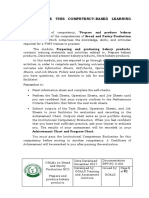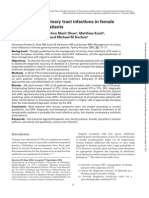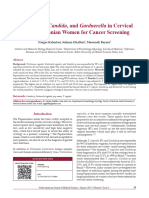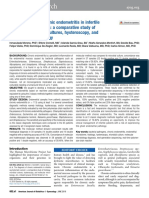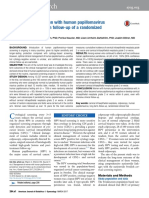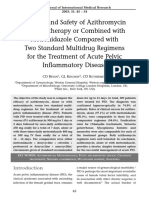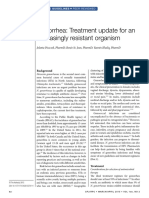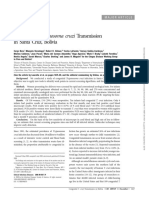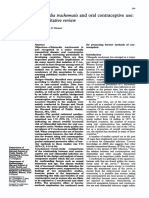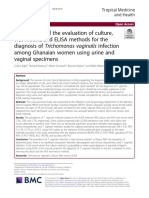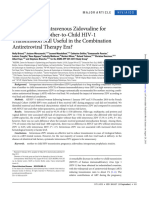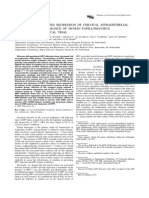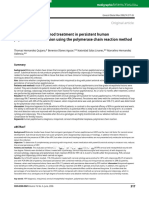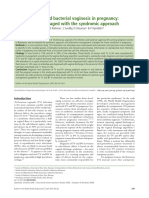The Syndromic Management of Vaginal Discharge Using Single-Dose Treatments: A Randomized Controlled Trial in West Africa
The Syndromic Management of Vaginal Discharge Using Single-Dose Treatments: A Randomized Controlled Trial in West Africa
Uploaded by
Iqra AnugerahCopyright:
Available Formats
The Syndromic Management of Vaginal Discharge Using Single-Dose Treatments: A Randomized Controlled Trial in West Africa
The Syndromic Management of Vaginal Discharge Using Single-Dose Treatments: A Randomized Controlled Trial in West Africa
Uploaded by
Iqra AnugerahOriginal Description:
Original Title
Copyright
Available Formats
Share this document
Did you find this document useful?
Is this content inappropriate?
Copyright:
Available Formats
The Syndromic Management of Vaginal Discharge Using Single-Dose Treatments: A Randomized Controlled Trial in West Africa
The Syndromic Management of Vaginal Discharge Using Single-Dose Treatments: A Randomized Controlled Trial in West Africa
Uploaded by
Iqra AnugerahCopyright:
Available Formats
The syndromic management of vaginal discharge using single-
dose treatments: a randomized controlled trial in West Africa
Jacques Pépin,a François Sobela,b Nzambi Khonde,b Thomas Agyarko-Poku,b Soumaila Diakité,b Sylvie Deslandes,a
Annie-Claude Labbé,c Mohamed Sylla,b Comfort Asamoah-Adu,b & Eric Frost a
Objective To evaluate whether single-dose treatments are as effective as standard therapy in the syndromic management of vaginal
discharge.
Methods A randomized controlled effectiveness trial compared single-dose tinidazole plus fluconazole (TF) with treatment for
7 days with metronidazole plus 3 days of treatment with vaginal clotrimazole (MC) among 1570 women presenting with vaginal
discharge at primary health care institutions in Ghana, Guinea, Mali and Togo. Participants were randomly allocated to one of the
two treatments by research nurses or physicians using precoded envelopes. Effectiveness was assessed by symptomatic response on
day 14.
Clinical identifier ClinicalTrials.gov NCT00313131.
Findings The two treatment regimens had similar effectiveness: complete resolution was seen in 66% (TF) and 64% (MC) and partial
resolution in 33% (TF) and 34% (MC) of participants (P = 0.26). Effectiveness was similar among subgroups with vulvovaginal
candidiasis, Trichomonas vaginalis vaginitis or bacterial vaginosis. The two treatment regimens had a similar effectiveness among
human immunodeficiency virus (HIV)-infected (TF: n = 76, 71% complete resolution, 28% partial; MC: n = 83, 72% complete
resolution, 25% partial, P = 0.76) and HIV-uninfected women (TF: n = 517, 68% complete, 32% partial; MC: n = 466, 65% complete,
33% partial, P = 0.20). Cervical infections with Neisseria gonorrhoeae, Chlamydia trachomatis and Mycoplasma genitalium were
uncommon among women not involved in sex work, were associated with bacterial vaginosis or T. vaginalis vaginitis, and did not
alter response to treatment with agents active against vaginal infections. Four-fifths of women not relieved by a single dose of TF
had a favourable response when MC was administered as second-line treatment.
Conclusion Single-dose TF is as effective as multiple-dose MC in the syndromic management of vaginal discharge, even among
women with HIV-infection. Given its low price and easier adherence, TF should be considered as a first-line treatment for vaginal
discharge syndrome.
Bulletin of the World Health Organization 2006;84:729-738.
Voir page 736 le résumé en français. En la página 736 figura un resumen en español. .737 ميكن االطالع عىل امللخص بالعربية يف صفحة
Introduction of interventions aimed primarily at incm thereof. In West Africa, classical agents of
creasing the use of condoms. cervicitis (Neisseria gonorrhoeae (NG) or
Despite the contradictory results of
Syndromic management implies Chlamydia trachomatis (CT)) are found
large trials in East Africa, the syndromic
the simultaneous treatment of two or in only 5–10% of women who are not
management of sexually transmitted
more infections: the higher cost of drugs SW and 10–25% of SW seeking treatmm
infections (STI) remains a public health is more than compensated by savings on ment for a vaginal discharge.7–11 To these
priority: whether or not it reduces transmm diagnostic assays, but adverse effects are pathogens must be added Mycoplasma
mission of human immunodeficiency more frequent and adherence to multm genitalium, recently identified as an agent
virus (HIV), this intervention relieves tiple-dose regimens can be suboptimal.1,2 of cervicitis in West Africa.10 The emergm
patients’ symptoms, lowers the risk of Whereas strategies for the syndromic gence of a generic drug industry in the
complications and reduces transmission management of STI in men are standm developing world has led to a significant
of etiological agents. 1–5 Within core dardized and very effective, this is not yet reduction in the cost of STI syndromic
groups such as sex workers (SW) and the case for vaginal discharge, which is management, even with single-dose
their clients, STI could be important by far the most common STI syndrome drugs.12–14 To determine whether single-
cofactors of HIV transmission even if among women.1,2 In the majority of dose therapy would be as effective as
this is less marked in the general adult cases, this syndrome is caused by either standard therapy in the context of
population. 6 Furthermore, effective bacterial vaginosis (BV), Trichomonas African primary health care institutions
management of STI among SW can vaginalis (TV) vaginitis, vulvovaginal providing care to populations with a
enhance the credibility and acceptability candidiasis (CA) or any combination relatively high prevalence of HIV, we
a
Department of Microbiology and Infectious Diseases, University of Sherbrooke, Centre Hospitalier Universitaire de Sherbrooke, 3001, 12ème Avenue Nord, Sherbrooke,
Quebec, Canada, J1H 5N4, Canada. Correspondence to Dr Jacques Pépin (email: jacques.pepin@usherbrooke.ca).
b
West Africa Project to Combat AIDS, Accra, Ghana; Lomé, Togo; Conakry, Guinea; Bamako, Mali.
c
Hôpital Maisonneuve-Rosemont, Montreal, Canada.
Ref. no. 06-029819
(Submitted: 10 January 2006 – Final revised version received: 18 April 2006 – Accepted: 5 May 2006 )
Bulletin of the World Health Organization | September 2006, 84 (9) 729
Research
Single-dose treatment of vaginal discharge Jacques Pépin et al.
conducted a randomized controlled trial the presence of BV (Nugent score >7) 15 chlamydial infections anticipated among
comparing the effectiveness of single- and/or yeasts compatible with Candida non-SW,10 no attempt was made to treat
dose tinidazole/fluconazole to that of albicans. The first cervical sample, depm their male partners.
a 7-day course of metronidazole plus posited in the Amplicor medium, was
intravaginal clotrimazole for 3 days. tested by polymerase-chain reaction Follow-up and outcomes
(PCR) for the presence of NG, CT and Participants were asked to come for a
Methods Mycoplasma genitalium (MG);7,10 the follow-up visit on day 14. A questionnm
second was used to measure the leukocm naire verified the subjective response
Sites and data collection
cyte count per high-power field (hpf ) as to treatment, which was the primary
This multicentre study involved nine
the mean of five counts. HIV serology outcome. A clinical examination was
health-care facilities in four West African
was performed on capillary blood using performed to document whether there
countries:
an algorithm of two different enzyme was an objective resolution of the vaginal
• in Ghana, the STI clinics of Accra-
immunoassays (Detect-HIV, Adaltis, discharge (secondary outcome). Vaginal
Adabraka and Kumasi-Suntreso;
Canada and Genie II HIV-1/HIV-2, and cervical samples were obtained
• in Guinea, the Madina and Carrière
Bio-Rad, France) and INNO-LIA HIV for Gram staining: other secondary
health centres, Conakry;
I/II Score (Innogenetics, Belgium) was outcomes were the disappearance of
• in Mali, the Korofina and Soutoura
health centres, Bamako; and used for the confirmation of discordant C. albicans and the resolution of BV
• in Togo, the STI clinics of Amoutivé results between the first and second in vaginal secretions. Participants still
and Agoé Nyivé (Lomé) and the health enzyme immunoassays. complaining of vaginal discharge were
centre of Adakpamé. Participants were identified only by given oral metronidazole (500 mg twice
a study number. Laboratory assays, incm a day for 7 days) and clotrimazole cream
The study protocol was approved by the cluding HIV serology, were performed (for 3 days) and asked to come back on
national ethics committee of each countm anonymously. Women wishing to know day 28. If this second treatment led to
try and by the institutional review board their HIV status received pre-test counsm no improvement, the choice of therapy
of the Centre Hospitalier Universitaire selling and a properly identified sample was then left to the discretion of local
de Sherbrooke, Canada. It was designed of venous blood was obtained. Processim health-care workers.
as an effectiveness trial, done under condm ing of this sample, post-test counselling,
ditions similar to those routinely seen and eventual referral to a facility providim Sample size and statistical
in these facilities. Between January 2004 ing treatment with antiretrovirals were analyses
and April 2005, we recruited women performed as routinely done for patients Aiming for 90% power, an alpha of
who consulted the health centre for a not participating in the study. 0.05, assuming that 50% of participm
vaginal discharge, regardless of HIV statm pants would have BV, that 25% of all
tus or involvement in transactional sex, Randomization women would be lost to follow-up and
who were local residents and consented Randomization, stratified according to that the effectiveness of a 7-day course
to participate. We excluded SW who whether or not the woman was a sex of metronidazole in women with BV
sought active screening for STI, pregnant worker, was conducted in each participm would be 90%, we needed 381 women
women, those whose main complaint pating centre by the research nurses or with BV in each group to show that
was lower abdominal pain and those allm physicians, using pre-coded envelopes. the difference in effectiveness between
lergic to one of the study drugs. Women Participants were randomly assigned to metronidazole and tinidazole would be
not eligible for the study were treated accm a group receiving either tinidazole 2 g, inferior to 10%. We aimed to enrol 1524
cording to the algorithms routinely used single dose and fluconazole 150 mg, participants. Data were analysed with
in the health facility. single dose or metronidazole 500 mg Stata 8.0 software. Categorical variables
At the initial visit, a questionnaire twice a day for 7 days and clotrimazole were compared using the c² or Fisher’s
was used to gather information on demm vaginal cream for 3 days. Women found test. Logistic regression was used for
mographic and behavioural characteristm to have at least one sign of cervicitis multivariate analysis.
tics, current complaints and the recent were given ciprofloxacin (500 mg, single
intake of antimicrobials. During gynaecm dose) and azithromycin (1 g, single Clinical identifier
cological examination, the presence of dose); those with a genital ulcer received ClinicalTrials.gov NCT00313131.
vulvar inflammation, the characteristics ciprofloxacin (500 mg twice a day for
of the discharge and signs of cervicitis 3 days) and benzathine penicillin (2.4
(mucopurulent cervical discharge, pus M units intramuscular, single dose). Results
on the swab, cervical bleeding after Fluconazole, tinidazole and, when necem A total of 811 women were randomly
sampling and cervical inflammation) essary, ciprofloxacin and azithromycin, assigned to receive tinidazole/fluconam
were noted. Two samples were obtained were swallowed by the patient under azole, and 759 to receive metronidazole/
from secretions in the vaginal fornix and direct observation. Patients allocated to clotrimazole (Table 1 and Trial profile
two from the endocervix, after cleaning the group receiving metronidazole and (Fig. 1)), suggesting that the randomizatm
the latter. The first vaginal sample was clotrimazole used these drugs at home. tion procedure was not always respected.
deposited in the Amplicor transport Because the study aimed to measure Nevertheless, the groups were well balam
medium (Roche, USA) and used for the effectiveness, generic drugs bought in anced and no significant difference was
detection of Trichomonas vaginalis; the West Africa were used. It would have seen between them in age, sex work,
second was used to deposit secretions on been impractical to use placebos. Given duration of discharge, prior treatment,
a slide which was Gram-stained to detect the low prevalence of gonococcal and presence of other symptoms, signs of
730 Bulletin of the World Health Organization | September 2006, 84 (9)
Research
Jacques Pépin et al. Single-dose treatment of vaginal discharge
Table 1. Baseline characteristics of the two treatment groups
Metronidazole + clotrimazole Tinidazole + fluconazole
(%) (%)
(n = 759) (n = 811)
Country
Ghana 352 (46) 350 (43)
Guinea 124 (16) 141 (17)
Mali 74 (10) 89 (11)
Togo 209 (28) 231 (28)
Age (years)
11–20 192 (25) 216 (27)
21–30 391 (52) 404 (50)
>30 176 (23) 191 (24)
Sex worker (SW)
Yes 281 (37) 304 (37)
No 478 (63) 507 (63)
Number of sex partners during last 3 months (non-SW only)
None 68 (14) 87 (17)
One 388 (82) 406 (80)
>2 20 (4) 13 (3)
Duration of vaginal discharge (days)
<7 314 (41) 323 (40)
8–14 169 (22) 173 (21)
>15 274 (36) 312 (39)
Other symptoms
Low abdominal pain 258 (34) 297 (37)
Dyspareunia 242 (32) 248 (31)
Dysuria 121 (16) 140 (17)
Vulvar pruritus 625 (82) 685 (84)
Prior treatment of current episode of vaginal discharge 224 (30) 233 (29)
Signs of cervicitis on examination
Cervical discharge 228 (30) 223 (27)
Pus on cervical swab 206 (27) 198 (24)
Cervical bleeding after sampling 98 (15) 96 (14)
Cervical inflammation 127 (17) 153 (19)
Cervical motion tenderness 164 (22) 195 (24)
Also given ciprofloxacin + azithromycin for presumed cervicitis 408 (54) 414 (51)
Also given ciprofloxacin + benzathine penicillin for genital ulcer 34 (4) 46 (6)
Leukocytes on cervical secretions (per hpf) a
<10 540 (71) 602 (74)
10–29 131 (17) 130 (16)
>30 85 (11) 77 (10)
Presence of pathogens
Non-sex workers
Vaginosis on Gram stain 234 (49) 224 (44)
Yeast cells on Gram strain 168 (35) 172 (34)
Trichomonas vaginalis 30 (6) 32 (6)
Chlamydia trachomatis (CT) 6 (1) 13 (3)
Neisseria gonorrhoeae (NG) 8 (2) 6 (1)
Mycoplasma genitalium (MG) 11 (2) 12 (2)
CT, NG or MG 24 (5) 29 (6)
Human immunodeficiency virus (HIV) 33 (8) 35 (8)
Bulletin of the World Health Organization | September 2006, 84 (9) 731
Research
Single-dose treatment of vaginal discharge Jacques Pépin et al.
(Table 1, cont.)
Metronidazole + clotrimazole Tinidazole + fluconazole
)%( )%(
)n = 759( )n = 811(
Sex workers
Vaginosis on Gram stain 135 (48) 136 (45)
Yeast cells on Gram stain 67 (24) 74 (24)
Trichomonas vaginalis 46 (16) 49 (16)
Chlamydia trachomatis 23 (8) 19 (6)
Neisseria gonorrhoeae 25 (9) 28 (9)
Mycoplasma genitalium 27 (10) 29 (10)
CT, NG or MG 60 (21) 64 (21)
HIV 77 (28) 75 (25)
a
hpf = high power field.
P-value was >0.05 for all comparisons.
cervicitis or the presence of various (Trial profile (Fig. 1)). The proportion of examination on day 14, neither overall
pathogens including HIV. As expected, women who reported either a complete nor when examining the subgroups desm
the prevalence of NG, CT, MG, TV resolution of the discharge or partial scribed above (data not shown).
and HIV was higher in SW than others, improvement on day 14 was similar Among women with vaginitis, we
whereas candidiasis was less common. in the two treatment groups (Table 3). examined the presence of abnormal findim
In both SW and non-SW, BV was found Both treatments had similar effectiveness ings on day 14 and their relation with
in almost half of participants. Among when analysis was restricted to subgroups: subjective or objective improvement of
non-SW, HIV prevalence varied from women with BV, those with candidiasis, the discharge. Among women with BV
3.6% in Ghana (13/359) to 9.6% in those with trichomoniasis and women on enrolment who were seen on day 14,
Guinea (13/135) and 10.7% in Togo with cervical infections (NG, CT and/or 165/542 (30%) still had a Nugent score
(42/394). MG). The two treatments had the same of 7 or more, but this was as frequent in
The association between MG and overall effectiveness among HIV-infected those with complete resolution of discm
cervicitis being relatively novel,10,16 we participants as among those who were charge (90/319, 28%) as in those with
first tested for this association with seronegative. The presence of a visible only partial or no improvement (72/215,
cervicitis, initially defining cervicitis as vaginal discharge on day 14 was highly 33%) (P = 0.23), as well as among those
a leukocyte count on cervical secretions correlated with the patient’s own percm with (75/240, 31%) or without a visible
>10/hpf. In a logistic regression analysis ception of response to treatment: 93% discharge (86/293, 29%) (P = 0.70).
that adjusted for age and the presence (14/15) of women reporting no improvemm However, among women with candidm
of other pathogens, presence of MG ment had a visible discharge on day 14 diasis on enrolment, yeasts were more
was associated with cervicitis (adjusted as did 86% (358/418) of those reporting frequently found on day 14 among
odds ratio (AOR): 2.0, 95% confidence partial improvement, compared to 15% those with partial or no improvement
interval (CI): 1.3–3.2, P = 0.004) as (116/759) of those reporting complete of symptoms (81/166, 49%) than those
was NG (AOR: 2.2, 95% CI: 1.3–3.6, resolution (P <0.001). There was no diffm with complete resolution (48/193, 25%)
P = 0.003) and CT (AOR: 1.7, 95% CI: ference between treatment groups for (P <0.001), and were also more common
1.0–3.0, P = 0.05). Subsequent analyses the presence of a vaginal discharge on among those with a visible discharge
thus considered women in whom any of
these three pathogens was present, alone
or in combination, as having cervical infm Fig. 1. Trial profile
fections. Interestingly, if we used a higher
(>30 leukocytes/hpf ) cut-off point 1570 randomized
to define cervicitis, NG (AOR: 2.4,
95% CI: 1.3–4.6, P = 0.007) and MG
(AOR: 2.0, 95% CI: 1.1–3.7, P = 0.02)
remained associated with cervicitis but 759 allocated to 811 allocated to
metronidazole + clotrimazole fluconazole + tinidazole
not CT (AOR: 1.2, 95% CI: 0.5–2.7,
P = 0.66). Women among whom at
least one agent of cervicitis was found
were more likely to also have BV and 168 lost to follow-up 157 lost to follow-up
TV vaginitis than those without cervical 1 primary outcome 2 primary outcomes
not recorded not recorded
infections (Table 2).
Four-fifths of participants attended
the follow-up visit on day 14 (metronm
590 analysed 652 analysed
nidazole/clotrimazole: 591/759, 78%;
tinidazole/fluconazole: 653/811, 81%) WHO 06.146
732 Bulletin of the World Health Organization | September 2006, 84 (9)
Research
Jacques Pépin et al. Single-dose treatment of vaginal discharge
Table 2. Associations between cervical and vaginal infections on day 0
Findings on day 0 Bacterial vaginosis/total Candidiasis/total Trichomonas vaginalis/total Any agent of vaginitis
(%) (%) (%) (%)
Presence of NG,a CT b
and/or MG c
Yes (n = 179) 111 (62) 43 (24) 42 (23) 138 (77)
No (n = 1406) 626 (45) 439 (31) 118 (8) 912 (65)
P-value 0.001 0.06 <0.001 0.001
a
NG = Neisseria gonorrhoeae.
b
CT = Chlamydia trachomatis.
c
MG = Mycoplasma genitalium.
(88/189, 47%) than those without any longer standard course of metronidazole The prevalence of TV among symptm
discharge (40/169, 24%) (P<0.001). (7 days)/clotrimazole (3 days) in women tomatic participants in the present study
Taking as a secondary outcome the presem presenting with vaginal discharge to primm was low, mirroring the results of populm
ence of yeasts on day 14, there was no mary health care facilities in four West lational surveys of asymptomatic women
difference between treatment groups African countries. The effectiveness of which documented a prevalence of only
among the HIV seronegatives or among the two treatments was similar when 3% in Cotonou (Benin), compared
those with HIV infection (data not examining all women, but also among to 18–34% in Yaoundé (Cameroon),
shown). subgroups selected according to the presem Kisumu (Kenya) and Ndola (Zambia).31
Of 433 women without complete ence of various etiological agents. Importm To treat T. vaginalis infections, WHO
resolution on day 14 who were then tantly, the two treatments were equally and others recommend as first choice,
treated with metronidazole/clotrimazole, effective in HIV-infected women. single-dose metronidazole (2 g),2,22,23
358 (83%) attended a further follow-up Bacterial vaginosis was the most which has an effectiveness comparable
visit on day 28: more than 80% of these common etiology of vaginal discharge, to that of a 5–7 day course of the same
women reported a complete resolution both among SW and non-SW, in line drug.25,26 Tinidazole was compared to
of the discharge on day 28, regardless with previous studies.17,18 We defined BV metronidazole in early randomized
of the treatment received on day 0 and using the Nugent score which, compared trials;32,33 a meta-analysis of these suggm
regardless of the presence of objective to the Amsel criteria, is simpler, more gested that single-dose tinidazole was
evidence of vaginosis or candidiasis on reproducible, and has reasonable sensitm superior to single-dose metronidazole.25
day 14 (Table 4). tivity and specificity.15,19–21 The standard We showed that single-dose tinidazole
Finally, we examined whether the treatment of BV is a 7-day course of was as effective against TV as 7 days of
presence of signs of cervicitis on exam metronidazole; single-dose metronidazm metronidazole.
amination was correlated with cervical zole is slightly less effective.2,20–23 The Previously, in sub-Saharan Africa,
infections (Table 5). Signs of cervicitis effectiveness of single-dose metronidazm the treatment of vaginal candidiasis
were not associated with the presence of zole in women with BV is lower among relied on nystatin, with unsatisfactory
NG, CT and/or MG. However, among those who are seropositive for HIV than results. Nystatin was replaced with azole-
SW the presence of NG, CT and/or MG in those who are seronegative.18 BV, containing creams, with better results.
was correlated with the leukocyte count an infection characterized by frequent A generic clotrimazole pessary remains
in cervical secretions, a higher prevalence relapses after initial improvement, has little used. Single-dose oral fluconazole
being seen as soon as the leukocyte count been the limiting step in the overall offers an interesting alternative, as it can
was >3/hpf. The presence of spermatozoa management of vaginal discharge with be combined with single-dose tinidazole
on Gram stains of vaginal secretions was single-dose therapies. Given its longer and given under direct observation.34
correlated with the presence of NG, CT half-life (12–14 hours versus 6–7 hours Generic fluconazole is now cheaper (US$
and/or MG. We examined the performm for metronidazole),24 tinidazole would 0.13 for 150 mg) than the clotrimazole
mance of determining the indication be expected to be more effective as a pessary (US$ 0.84).12–14 Whether vulvovm
for providing treatment for cervical single-dose therapy. It is better tolerated vaginal candidiasis is more common or
infections based on the presence of a than metronidazole 25,26 and very cheap more likely to recur among HIV-infected
leukocyte count >4/hpf. Among SW (wholesale price per 2 g dose ≈ US$ women is controversial, and there was
this approach had a sensitivity of 64% 0.07). Studies of single-dose tinidazole little information on the effectiveness of
(79/123) and a positive predictive value in women with BV have shown a wide single-dose fluconazole in HIV-infected
of 30% (79/264). Among non-SW the range of effectiveness (51–97%) 27–30 women.35 We found no difference in
sensitivity was 53% (28/53) and the positm but used different definitions of BV and effectiveness between fluconazole and
cure. Experts now agree that the goal of clotrimazole in HIV-infected participm
tive predictive value only 7% (28/413).
BV treatment is symptomatic relief.20 pants, and no difference in response betm
In this regard, single-dose tinidazole tween HIV-infected and HIV-negative
Discussion was equivalent to a week of treatment women with candidiasis.
A combination of single-dose tinidazm with metronidazole, even among HIV- Signs of cervicitis on examination
zole/fluconazole was as effective as the infected women. were not reliable predictors of cervical
Bulletin of the World Health Organization | September 2006, 84 (9) 733
Research
Single-dose treatment of vaginal discharge Jacques Pépin et al.
Table 3. Subjective response to treatment as assessed on day 14 according to treatment group and the presence of various
pathogens on day 0
Treatment group Symptomatic response on day 14 P-value
Complete resolution Partial resolution No improvement
(%) (%) (%)
Overall
Metronidazole/clotrimazole 377 (64) 203 (34) 10 (2)
Tinidazole/fluconazole 432 (66) 215 (33) 5 (1) 0.26
Candidiasis present on day 0
Metronidazole/clotrimazole 110 (57) 78 (40) 5 (3)
Tinidazole/fluconazole 120 (58) 85 (41) 1 (0.5) 0.23
Bacterial vaginosis present on day 0
Metronidazole/clotrimazole 179 (62) 101 (35) 7 (2)
Tinidazole/fluconazole 188 (63) 110 (37) 1 (0.5) 0.09
T. vaginalis present on day 0
Metronidazole/clotrimazole 37 (62) 22 (37) 1 (2)
Tinidazole/fluconazole 43 (66) 21 (32) 1 (2) 0.87
NG,a CT b and/or MG c present on day 0
Metronidazole/clotrimazole 47 (77) 14 (23) 0 (0) 0.50
Tinidazole/fluconazole 50 (70) 20 (28) 1 (1)
HIV seronegatives
Metronidazole/clotrimazole 304 (65) 154 (33) 8 (2)
Tinidazole/fluconazole 350 (68) 164 (32) 3 (1) 0.20
HIV-infected
Metronidazole/clotrimazole 55 (72) 19 (25) 2 (3) 0.76
Tinidazole/fluconazole 59 (71) 23 (28) 1 (1)
Ghana
Metronidazole/clotrimazole 154 (73) 51 (24) 5 (2) 0.21
Tinidazole/fluconazole 165 (77) 48 (22) 1 (0.5)
Guinea
Metronidazole/clotrimazole 88 (75) 29 (25) 0 (0) 0.24
Tinidazole/fluconazole 92 (68) 44 (32) 0 (0)
Mali
Metronidazole/clotrimazole 40 (55) 32 (44) 1 (1) 0.65
Tinidazole/fluconazole 54 (61) 33 (37) 2 (2)
Togo
Metronidazole/clotrimazole 95 (50) 91 (48) 4 (2) 0.29
Tinidazole/fluconazole 121 (57) 90 (42) 2 (1)
a
NG = Neisseria gonorrhoeae.
b
CT = Chlamydia trachomatis.
c
MG = Mycoplasma genitalium.
infections. Of 560 non-SW women with attempting to identify non-SW with managing cervical infections among SW.
>1 sign of cervicitis given ciprofloxacin/ cervical infections seems pointless. Early in an intervention, when condom
azithromyin, only 30 (5.4%) had a cervicm Control of NG, CT and MG in the use is low and prevalences of cervical
cal infection. Most women with cervical general population of African countries infections are high, administering drugs
infection also had vaginitis, which most requires these infections to be controlled active against agents of cervicitis to all
likely prompted their consultation; among SW: decreasing transmission to SW will have a sensitivity of 100% and
indeed, presumably because of their their clients will ultimately reduce infm a positive predictive value equal to the
association with sexual activity, BV and fections among women not involved in prevalence. Later on, when prevalence
TV were more common among women transactional sex. Effective single-dose of cervical infections decreases, the ecolm
with cervical infections. Only 53 (5.4%) treatments for gonorrhoea and chlamydia logical disadvantages (selective pressure
of non-SW were infected with NG, CT are available, although the emergence for resistance) become a consideration:
and/or MG; of these only 18 and 28 had of ciprofloxacin-resistant gonococci in treatment active against agents of cervical
>10 and > 4 leukocytes/hpf, respectm South Africa is a matter for concern.36 infections might then be given only to
tively. In light of these low prevalences, There are two possible approaches for SW with >4 leukocytes/hpf in cervical
734 Bulletin of the World Health Organization | September 2006, 84 (9)
Research
Jacques Pépin et al. Single-dose treatment of vaginal discharge
Table 4. Subjective response to a second treatment (metronidazole and clotrimazole given on day 14) as assessed on day 28
according to various characteristics
Symptomatic response on day 28 P-value
Complete resolution Partial resolution No improvement
(%) (%) (%)
Treatment received on day 0
Metronidazole/clotrimazole 142 (81) 31 (18) 2 (1) 1.00
Tinidazole/fluconazole 148 (81) 33 (18) 2 (1)
Bacterial vaginosis on day 14
Absent 210 (80) 51 (19) 3 (1) 0.68
Present 72 (84) 13 (15) 1 (1)
Yeast cells on day 14
Absent 176 (79) 42 (19) 4 (1) 0.28
Present 106 (83) 22 (17) 0 (0)
HIV
Negative 243 (84) 44 (15) 3 (1) 0.70
Positive 33 (80) 7 (14) 1 (2)
secretions. However, this implies that
Table 5. Associations between various characteristics and the presence of cervical
roughly half of SW receive ciprofloxacin/ infections with Neisseria gonorrhoeae (NG), Chlamydia trachomatis (CT)
azithromycin and that Gram stains are and/or Mycoplasma genitalium (MG)
available. The development of affordable,
sensitive, specific, rapid, user-friendly Findings on day 0 Sex workers Non-sex workers
and equipment-free tests to diagnose
gonococcal and chlamydial infections Presence of NG, CT or Presence of NG, CT or
in women has been a laborious process, MG/total (%) MG/total (%)
further complicated by the recent identm Cervical discharge
tification of M. genitalium as a third Absent 88/421 (21) 36/698 (5)
agent of cervicitis.10,16 The development Present 36/164 (22) 17/287 (6)
of cheap dipsticks that would detect the Pus on cervical swab
presence of leukocytes might be more Absent 85/408 (21) 37/757 (5)
easily attainable. Present 39/177 (22) 16/227 (7)
Cross-sectional and cohort studies Cervical bleeding after
have examined the association between sampling
HIV and vaginitis.37–42 A meta-analysis Absent 82/400 (21) 39/747 (5)
estimated that the risk of acquiring Present 15/48 (31) 10/146 (7)
HIV was increased 1.4–2.2-fold by BV, Cervical inflammation
TV and candidiasis.40 Although there Absent 96/446 (22) 47/843 (6)
is no evidence that adequate treatment Present 28/139 (20) 6/141 (4)
of BV reduces the risk of HIV, the
high prevalence of BV suggests that Cervical motion tenderness
its population attributable fraction of Absent 94/443 (21) 44/767 (6)
incident HIV among women could be Present 30/142 (21) 9/217 (4)
substantial.37 HIV vaginal shedding is Leukocytes on cervical
higher in women with candidiasis, and secretions (per hpf)
is reduced by treatment of candidiasis 0–3 44/318 (14) 25/570 (4)
and TV.43,44 4–9 24/97 (25) 10/157 (6)
10–29 30/105 (29) 12/156 (8)
>30 25/62 (40) a 6/100 (6)
Conclusions
Spermatozoa
Among non-SW at low risk for HIV, the Absent 108/534 (20) 47/940 (5)
goal is symptomatic relief and single- Present 16/51 (31) 6/37 (14) b
dose tinidazole/fluconazole could be
Were given ciprofloxacin +
used as the initial treatment for vaginal
azithromycin
discharge, because it is convenient,
No 66/322 (20) 23/420 (5)
well tolerated and cheap (wholesale
Yes 58/262 (22) 30/560 (5)
price: US$ 0.20). Most women who do
not respond to tinidazole/fluconazole a
P <0.05.
are cured when given as second-line b
P <0.001.
Bulletin of the World Health Organization | September 2006, 84 (9) 735
Research
Single-dose treatment of vaginal discharge Jacques Pépin et al.
treatment a standard course of metronm through its West Africa Project to (CS Carrière), Dr Thierno Amadou
nidazole/clotrimazole (wholesale price: Combat AIDS and STI in West Africa, Koundouno (CS Madina); Mali, Dr
US$ 1.06). Among SW, in addition to and by the United States Agency for Sidibé Garangué Souko (CS Soutoura)
symptomatic relief, this visit to a health International Development and Family and Dr Fatoumata Binta Keita (CS
worker should be used as an opportunm Health International. Korofina); Togo, Dr Adom W. Kpao,
nity for promotion of condom use and The following people made impm Director of the National AIDS/STI
screening for cervical infections. O portant contributions to this project: Control Programme, Dr Kéré Banla
Canada, Josée Ducharme and Andrée Abiba, Director of the Institut National
Acknowledgements Grondin, who interpreted the Gram d’Hygiène (INH) and her staff.
This study was funded by the Canadian stains; Guinea, Dr Thierno Mouctar
International Development Agency Diallo and Dr Fatoumata Binta Bah Competing interests: none declared.
Résumé
Prise en charge syndromique de la leucorrhée par des traitements sous forme de dose unique : essai
contrôlé randomisé en Afrique de l’Ouest
Objectif Evaluer l’efficacité comparative des traitements par deux traitements était similaire chez les femmes infectées par le
dose unique et du traitement standard pour la prise en charge virus de l’immunodéficience humaine (VIH) (TF : n = 76, résolution
syndromique de la leucorrhée. complète 71 %, résolution partielle 28 % ; MC : n = 83, résolution
Méthodes Un essai contrôlé randomisé a comparé l’efficacité complète 72 %, résolution partielle 25 %, p = 0,76) et chez les
d’une dose unique de l’association tinidazole/ fluconazole (TF) à femmes non infectées par le VIH (TF : n = 517, résolution complète
celle d’un traitement de sept jours par le métronidazole, complété 68 %, résolution partielle 32 % ; MC : n = 466, résolution complète
par trois jours sous clotrimazole vaginal (MC), chez 1570 femmes 65 %, résolution partielle 33 %, p = 0,20). Les infections du col
présentant une leucorrhée accueillies par des centres de soins par Neisseria gonorrhoeae, Chlamydia trachomatis et Mycoplasma
de santé primaires au Ghana, en Guinée, au Mali et au Togo. Les genitalium étaient peu fréquentes chez les femmes ne pratiquant
participantes ont été réparties de manière aléatoire au moyen pas le commerce du sexe, étaient associées à une vaginose
d’enveloppes précodées en deux groupes de traitement par les bactérienne ou à une vaginite à T. vaginalis et ne modifiaient pas
infirmières ou les médecins chargés de mener l’étude. L’efficacité la réponse au traitement par des agents actifs contre les infections
thérapeutique a été évaluée d’après la réponse symptomatique vaginales. Chez les quatre-cinquièmes des femmes qui n’avaient
au quatorzième jour. pas été soulagées par une dose unique de TF, on a observé une
Identificateur clinique ClinicalTrials.gov NCT00313131. réponse favorable lors de l’administration de MC comme traitement
Résultats On a constaté une efficacité similaire pour les deux de deuxième intention.
traitements : on a observé une résolution complète chez 66 % Conclusion L’association TF sous forme de dose unique est aussi
des participantes traitées par TF et chez 64 % de celles traitées efficace que l’association MC administrée en plusieurs doses
par MC ainsi qu’une résolution partielle chez 33 % des femmes dans la prise en charge syndromique de la leucorrhée, même
traitées par TF et 34 % des femmes traitées par MC (p = 0,26). chez les femmes infectées par le VIH. Compte tenu de son coût
Une efficacité analogue a également été constatée chez les sous- peu élevé et de l’observance plus facile, il faudrait envisager de
groupes présentant une candidose vulvovaginale, une vaginite à classer l’association TF parmi les traitements de première intention
Trichomonas vaginalis ou une vaginose bactérienne. L’efficacité des de la leucorrhée.
Resumen
Manejo sindrómico del flujo vaginal mediante tratamientos de dosis única: ensayo controlado aleatorizado
en África Occidental
Objetivo Determinar si los tratamientos de dosis única son los casos, y curación parcial en el 33% (TF) y el 34% (MC) de los
eficaces como terapia estándar en el manejo sindrómico del flujo casos (P = 0,26). La eficacia fue similar entre los subgrupos con
vaginal. candidiasis vulvovaginal, vaginitis por Trichomonas vaginalis o
Métodos En un ensayo controlado aleatorizado se comparó vaginosis bacteriana. Los dos regímenes terapéuticos tuvieron
la eficacia de una dosis única de tinidazol y fluconazol (TF) con también parecida eficacia en las pacientes infectadas por el virus de
la de un tratamiento con metronidazol durante 7 días seguido la inmunodeficiencia humana (VIH) (TF: n = 76, curación completa
de clotrimazol vaginal durante 3 días más (MC) en un total de en el 71% de los casos, y parcial en el 28% de los casos; MC:
1570 mujeres que acudieron con problemas de flujo vaginal a n = 83, curación completa en el 72% de los casos, y parcial en el
establecimientos de atención primaria de Ghana, Guinea, Malí 25%; P = 0,76) y las no infectadas por el VIH (TF: n = 517, curación
y Togo. Utilizando sobres precodificados, enfermeras y médicos completa en el 68% de los casos, y parcial en el 32%; MC: n = 466,
investigadores asignaron aleatoriamente a las participantes a curación completa en el 65% de los casos, y parcial en el 33%; P =
alguno de los dos tratamientos. La eficacia se evaluó determinando 0,20). Las infecciones cervicouterinas por Neisseria gonorrhoeae,
la respuesta sintomática a los 14 días. Chlamydia trachomatis y Mycoplasma genitalium eran infrecuentes
Identificador clínico ClinicalTrials.gov NCT00313131. entre las mujeres que no eran profesionales del sexo, se asociaban
Resultados Los dos regímenes terapéuticos tuvieron una eficacia a vaginosis bacteriana o vaginitis por T. vaginalis, y no influían
parecida: curación completa en el 66% (TF) y el 64% (MC) de en la respuesta al tratamiento con productos activos contra las
736 Bulletin of the World Health Organization | September 2006, 84 (9)
Research
Jacques Pépin et al. Single-dose treatment of vaginal discharge
infecciones vaginales. Las cuatro quintas partes de las mujeres que entre las mujeres con infección por VIH. Teniendo en cuenta su bajo
no respondían a una dosis única de TF presentaron una respuesta precio y el mayor cumplimiento del régimen, la combinación TF
favorable al uso de MC como tratamiento de segunda línea. debería ser siempre una alternativa a considerar como tratamiento
Conclusión La dosis única de TF es tan eficaz como las dosis de primera línea del síndrome de flujo vaginal.
múltiples de MC en el manejo sindrómico del flujo vaginal, incluso
ملخص
:التدبري وفق املتالزمات للمفرزات املهبلية باملعالجة بجرعة وحيدة
دراسة معشاة مضبوطة بالشواهد يف غرب أفريقيا
فبالنسبة للمعالجة بجرعة وحيدة بالتينيدازول مع الفلوكونازول تحقق تقيـيم ما إذا كانت املعالجة بجرعة وحيدة تـتمتع بنفس فعّالية:الهدف
أما، مصابة76 من بني%28 والشفاء الجزيئ لدى%71 الشفاء التام لدى .املعالجة املعيارية يف التدبري وفق املتالزمات للمفرزات املهبلية
فقد تحقق الشفاء،بالنسبة للمعالجة بامليتـرينيدازول والكلوترميازول املهبيل قارنت دراسة معشاة مضبوطة بالشواهد فعّالية جرعة وحيدة من:الطريقة
(وقيمة، مصابة83 من بني%25 والشفاء الجزيئ لدى%72 التام لدى التينيدازول والفلوكونازول مع فعالية املعالجة ملدة سبعة أيام بامليتـرونيدازول
، مصابة517 وبني غري املصابات بعدوى اإليدز وعددهن.)0.76 االحتامل وشملت الدراسة،باإلضافة إىل ثالثة أيام من املعالجة بالكلوتـرميازول املهبيل
ممن عولجت بجرعة وحيدة بالتينيدازول%68 فقد تحقق الشفاء التام لدى امرأة تعاين من مفرزات مهبلية يف مؤسسات الرعاية الصحية األولية يف1570
كام تحقق الشفاء، منهن%32 وتحقق الشفاء الجزيئ لدى،مع الفلوكونازول وقد وزع األطباء أو املمرضات املرشفات عىل.كل من غانا وغينيا ومايل وتوغو
ممن عولجن بامليرتينيدازول والكلوتريمازول املهبيل وعددهن%65 التام لدى هذه الدراسة املريضات الاليت شاركن يف الدراسة ضمن واحد من النظام نَْي
ومل.)0.20 (وقيمة االحتامل، منهن%33 والشفاء الجزيئ لدى، مريضة466 وأجري تقيـيم أعراض،العالجيَّـْني باستخدام مظاريف مسبقة التـرميز
تكن العدوى بالكالميديا الحرثية واملصورات التناسلية شائعة بني الاليت ال .االستجابة يف اليوم الرابع عرش
ولكنها تـرافقت مع التهاب املهبل الجرثومي أو التهاب املهبل،يقتـرفن البغاء )) دراسات رسيرية (( إكلينيكية:)الرقم التعريفي الرسيري (اإلكلينييك
دون أن يغري ذلك من االستجابة للمعالجة بأدوية فعَّالة،باملشعرات املهبلية )NCT00313131(
ً وقد تحسَّ ن أربعة أخامس النسوة الاليئ مل يستجنب جيدا.ضد العدوى املهبلية لقد كان للنظام نَْي العالجيَّـْني نفس الفعَّالية؛ فقدشوهد الشفاء:املوجودات
للمعالجة بجرعة وحيدة من التينيدازول مع الفلوكونازول بعد معالجتهن من الحاالت املعالجة بجرعة وحيدة بالتينيدازول مع%66 التام لدى
. ٍبامليرتينيدازول والكلوترميازول املهبيل كخطٍ عالجي ثان من الحاالت املعالجة بامليتـريندازول والكلوتريمازول%64 الفلوكونازول ولدى
إن املعالجة بجرعة وحيدة من التينيدازول والفلوكونازول تضاهي:االستنتاج من الحاالت املعالجة بجرعة%33 كام شوهد الشفاء الجزيئ لدى،املهبيل
بفعاليتها املعالجة بجرعات متعددة من امليرتينيدازول والكلوترميازول املهبيل من الحاالت املعالجة%34 وحيدة بالتينيدازول مع الفلوكونازول ولدى
ونظراً النخفاض، حتى لدى النساء املصابات باإليدز،يف تدبري املفرزات املهبلية كام.)0.26 بامليتـرونيدازول والكلوترميازول املهبيل (وكانت قيمة االحتامل
سعر الجرعة الوحيدة وسهولة االمتثال لها ينبغي اعتبارها الخط األول من كانت الفعّالية متشابهة لدى املجموعات الفرعية التي تعاين من التهاب
.املعالجة ملتالزمة املفرزات املهبلية املهبل والفرج بالـ ِم ْبيَضّ ات والتهاب املهبل باملشعّرة املهبلية أو التهاب املهبل
، وقد كان للنظام نَْي العالجيَّـْني نفس الفعالية لدى املصابات باإليدز.بالجراثيم
References
1. Dallabetta G, Gerbase A, Holmes KK. Problems, solutions, and challenges in 8. Alary M, Mukenge-Tshibaka, Bernier F, Geraldo N, Lowndes CM, Méda H, et al.
syndromic management of sexually transmitted diseases. Sex Transm Infect Decline in the prevalence of HIV and sexually transmitted disease among
1998;74: Suppl 1:S1-S11. female sex workers in Cotonou, Benin, 1993-1999. AIDS 2002;16:463-70.
2. World Health Organization. Guidelines for the management of sexually 9. Ghys PD, Diallo MO, Ettiègne-Traoré V, Kalé K, Tawil O, Carael M, et al.
transmitted infections. Geneva: WHO; 2003. Availble from: http://whqlibdoc. Increase in condom use and decline in HIV and sexually transmitted diseases
who.int/publications/2003/9241546263.pdf among female sex workers in Abidjan, Côte d’Ivoire, 1991-1998. AIDS
3. Grosskurth H, Mosha F, Todd J, Mwijarubi E, Klokke A, Senkoro K, et al. Impact 2002;16:251-8.
of improved treatment of sexually transmitted diseases on HIV infection in 10. Pepin J, Labbé AC, Khonde N, Deslandes S, Alary M, Dzokoto A, et al.
rural Tanzania: randomised controlled trial. Lancet 1995;346:530-6. Mycoplasma genitalium: an organism commonly associated with cervicitis
4. Wawer MJ, Sewankambo NK, Serwadda D, Quinn TC, Paxton LA, Kiwanuka N, among West African sex workers. Sex Transm Infect 2005:81:67-72.
et al. Control of sexually transmitted disease for AIDS prevention in Uganda: a 11. Ndoye I, Mboup S, De Schryver A, Van Dyck E, Moran J, Samb ND, et al.
randomised community trial. Lancet 1999;353:525-35. Diagnosis of sexually transmitted infections in female prostitutes in Dakar,
5. Kamali A, Quigley M, Nakiyingi J, Kinsman J, Kengeya-Kayondo J, Gopal R, Senegal. Sex Transm Infect 1998;74 Suppl 1:S112-17.
et al. Syndromic management of sexually transmitted infections and 12. Pépin J, Mabey D. Sexually transmitted infections in Africa: single dose
behaviour change interventions on transmission of HIV-1 in rural Uganda: a treatment is now affordable. Sex Transm Infect 2003;79:432-4.
community randomised trial. Lancet 2003;361:645-52. 13. United Nations Children’s Fund-Joint United Nations Programme on
6. Kaul R, Kimani J, Nagelkerke NJ, Fonck K, Ngugig EN, Keli F, et al. Monthly HIV/AIDS-World Health Organization-Medecins sans Frontieres. Sources and
antibiotic chemoprophylaxis and incidence of sexually transmitted infections prices of selected medicines and diagnostics for people living with HIV/AIDS.
and HIV-1 infection in Kenyan sex workers. A randomized controlled trial. Geneva: UNICEF-UNAIDS-WHO-MSF; 2005. Available from:http://www.who.
JAMA 2004;291:2555-62. int/3by5/amds/sourcesAug05.pdf
7. Pepin J, Sobela F, Alary M, Deslandes S, Kintin F, Khonde N, et al. Low 14. International Dispensary Association. Price indicator. Amsterdam: International
prevalence of cervical infections in women with vaginal discharge in West Dispensary Association; August 2005.
Africa: implications for syndromic management. Sex Transm Infect 2004;
80:230-5.
Bulletin of the World Health Organization | September 2006, 84 (9) 737
Research
Single-dose treatment of vaginal discharge Jacques Pépin et al.
15. Nugent RP, Krohn MA, Hillier SL. Reliability of diagnosing bacterial vaginosis 30. Mohanty KC, Deighton R. Comparison of 2 g single dose of metronidazole,
is improved by a standardised method of Gram stain interpretation. J Clin nimorazole and tinidazole in the treatment of vaginitis associated with
Microbiol 1991;29:297-301 Gardnerella vaginalis. J Antimicrob Chemother 1987;19:393-9.
16. Manhart LE, Critchlow CW, Holmes KK, Dutro SM, Eschenbach DA, Stevens 31. Buvé A, Weiss HA, Laga M, Van Dyck E, Musonda R, Zekeng L, et al. The
CE, et al. Mucopurulent cervicitis and Mycoplasma genitalium. J Infect Dis epidemiology of trichomoniasis in women in four African cities. AIDS 2001;
2003;187:650-7. 15 Suppl 4:S89-S96.
17. Behets FMT, Andriamiadana J, Randrianasolo D, Rasamilalao D, Ratsimbazafy 32. Sawyer PR, Brogden RN, Pinder RM, Speight TM, Avery GS. Tinidazole: a
N, Dallabetta G , et al. Laboratory diagnosis of sexually transmitted infections review of its antiprotozoal activity and therapeutic efficacy. Drugs 1976;
in women with genital discharge in Madagascar: implications for primary 11:423-40.
care. Int J STD AIDS 2002;13:606-11. 33. Apte VV, Packard RS. Tinidazole in the treatment of trichomoniasis, giaridasis
18. Moodley P, Wilkinson D, Connolly C, Sturm AW. Influence of HIV-1 coinfection and amoebiasis. Report of a multicentre study. Drugs 1978;15 Suppl 1:43-8.
on effective management of abnormal vaginal discharge. Sex Transm Dis 34. Watson MC, Grimshaw JM, Bond CM, Mollison J, Ludbrook A. Oral versus
2003;30:1-5. intravaginal imidazole and triazole anti-fungal treatment of uncomplicated
19. Sobel J. Vaginitis. N Engl J Med 1997;337:1896-903. vulvovaginal candidiasis (thrush). Cochrane Database Systematic Reviews,
20. Joesoef MR, Schmid GP, Hillier SL. Bacterial vaginosis: review of treatment latest update 22 May 2002.
options and potential clinical indications for therapy. Clin Infect Dis 1998; 35. Sobel J. Gynecologic infections in HIV-infected women. Clin Infect Dis 2000;
28 Suppl 1:S57-S65. 31: 1225-33.
21. Koumans EH, Markowitz LE, Hogan V, for the CDC BV Working Group. 36. Moodley P, Sturm AW. Ciprofloxacin-resistant gonorrhoea in South Africa.
Indications for therapy and treatment recommendations for bacterial Lancet 2005;366:1159.
vaginosis in non-pregnant and pregnant women: a synthesis of data. Clin 37. Schmid G, Markowitz L, Joesoef R, Koumans E. Bacterial vaginosis and HIV
Infect Dis 2002;35 Suppl 2:S152-S172. infection. Sex Transm Infect 2000;76:3-4.
22. Centers for Disease Control and Prevention. Sexually transmitted diseases 38. Myer L, Denny L, Telerant R, de Souza M, Wright TC, Kuhn L. Bacterial
treatment guidelines 2002. Morbidity and Mortality Weekly Report vaginosis and susceptibility to HIV infection in South African women: a nested
2002;51(RR-6):1-82. Available from: http://www.cdc.gov/std/treatment/ case-control study. J Infect Dis 2005;192:1372-80.
rr5106.pdf 39. Fleming DT, Wasserheit JN. From epidemiological synergy to public health
23. Clinical Effectiveness Group. UK national guidelines on sexually transmitted policy and practice: the contribution of other sexually transmitted diseases
infections and closely related conditions. Sex Transm Infect 1999; to sexual transmission of HIV infection. Sex Transm Infect 1999;75:3-17.
75: Suppl 1:S1-S88. 40. Rottingen JA, Cameron DW, Garnett GP. A systematic review for the
24. Chaikin P, Alton KB, Sampson C, Weintraub HS. Pharmacokinetics of tinidazole epidemiologic interactions between classic sexually transmitted diseases
in male and female subjects. J Clin Pharmacol 1982;22:562-70. and HIV. How much is really known? Sex Transm Dis 2001;28:579-97.
25. Forna F, Gulmezoglu AM. Interventions for treating trichomoniasis in women. 41. Martin HL, Richardson B, Nyange PM, Lavreys L, Hillier SL, Chohan B, et al.
The Cochrane Database of Systematic Reviews. Latest update: 22-6-2005. Vaginal lactobacilli, microbial flora and risk of HIV-1 and STD acquisition. J
26. Gulmezoglu AM, Garner P. Trichomoniasis treatment in women: a systematic Infect Dis 1999;180:1863-8.
review. Trop Med Int Health 1998;3:553-8. 42. Taha T, Hoover DR, Dallabetta GA, Kumwenda NI, Mtimavalye LA, Yang LP,
27. Schindler EM, Thamm H, Ansmann EB, Sarnow E, Schindler AE. Treatment of et al. Bacterial vaginosis and disturbances of vaginal flora: association with
bacterial vaginitis. Multicenter, randomized, open study with tinidazole in increased acquisition of HIV. AIDS 1998;12:1699-706.
comparison with metronidazole. Fortschr Med Orig 1991;109:138-40. 43. Mostad SB, Overbaugh J, DeVange DM, Welch MJ, Chohan B, Mandaliya K,
28. Ekgren J, Norling BK, Degre M, Midtvert T. Comparison of tinidazole given et al. Hormonal contraception, vitamin A deficiency and other risk factors
as a single dose and on 2 consecutive days for the treatment of non-specific for shedding of HIV-1-infected cells from the cervix and vagina. Lancet 1997;
bacterial vaginosis. Gynecol Obstet Invest 1988;26:313-7. 350:922-7.
29. Vutyavanich T, Pongsuthirak P, Vannareumol P, Ruangsri R, Luangsook. A 44. Wang CC, McClelland RS, Reilly M, Overbaugh J, Emery SR, Mandaliya K,
randomised double-blind trial of tinidazole treatment of the sexual partners et al. The effect of treatment of vaginal infections on shedding of human
of females with bacterial vaginosis. Obstet Gynecol 1993;82:550-4. immunodeficiency virus type 1. J Infect Dis 2001;183:1017-22.
738 Bulletin of the World Health Organization | September 2006, 84 (9)
You might also like
- Wbs and Division of Work Excel Spread Sheet1Document12 pagesWbs and Division of Work Excel Spread Sheet1Adrian Christian Lee100% (1)
- Iso 22000 ManualDocument62 pagesIso 22000 ManualPrakash Rathod100% (9)
- Operational Requirements NCO NCC SPODocument19 pagesOperational Requirements NCO NCC SPOloicfrevilleNo ratings yet
- COC 1 Prepare and Produce Bakery ProductsDocument81 pagesCOC 1 Prepare and Produce Bakery Productszander prospero88% (8)
- Clinical Characteristicsof Mycoplasmagenitaliumandthe Usefulnessof Syndromic Management Among Women Living With Human Immunodeficiency VirusDocument4 pagesClinical Characteristicsof Mycoplasmagenitaliumandthe Usefulnessof Syndromic Management Among Women Living With Human Immunodeficiency VirusThania WazintaNo ratings yet
- The Efficacy and Safety of Gentamicin Plus Azithromycin and Gemifloxacin Plus Azithromycin As Treatment of Uncomplicated GonorrheaDocument9 pagesThe Efficacy and Safety of Gentamicin Plus Azithromycin and Gemifloxacin Plus Azithromycin As Treatment of Uncomplicated GonorrheaCindy Julia AmandaNo ratings yet
- Current Chlamydia Trachomatis Infection, A Major Cause of InfertilityDocument7 pagesCurrent Chlamydia Trachomatis Infection, A Major Cause of InfertilityRiany Jade SabrinaNo ratings yet
- The Ef Ficacy and Safety of Gentamicin Plus Azithromycin and Gemi Oxacin Plus Azithromycin As Treatment of Uncomplicated GonorrheaDocument9 pagesThe Ef Ficacy and Safety of Gentamicin Plus Azithromycin and Gemi Oxacin Plus Azithromycin As Treatment of Uncomplicated GonorrheaSamuelRexyNo ratings yet
- Original Article Vaginal Discharge: Perceptions and Health Seeking Behavior Among Nepalese WomenDocument5 pagesOriginal Article Vaginal Discharge: Perceptions and Health Seeking Behavior Among Nepalese WomennovywardanaNo ratings yet
- Management of Urinary Tract Infections in Female General Practice PatientsDocument7 pagesManagement of Urinary Tract Infections in Female General Practice PatientsCosmin CalanciaNo ratings yet
- 1 s2.0 S0140673622005384 MainDocument11 pages1 s2.0 S0140673622005384 Mainwahyuni yuniNo ratings yet
- Prevalence and Associated Factors of HIV Infection Among Pregnant Women Attending Antenatal Care at The Yaoundé Central HospitalDocument6 pagesPrevalence and Associated Factors of HIV Infection Among Pregnant Women Attending Antenatal Care at The Yaoundé Central HospitalnabilahbilqisNo ratings yet
- Comment: Pallidum-The Syphilis AgentDocument2 pagesComment: Pallidum-The Syphilis AgentM AlbertNo ratings yet
- Management of Urinary Tract Infections in Female General Practice PatientsDocument7 pagesManagement of Urinary Tract Infections in Female General Practice PatientsGede ArianaNo ratings yet
- 7340-Article Text-59925-2-10-20240702Document6 pages7340-Article Text-59925-2-10-20240702dtmms92No ratings yet
- Sexually Transmitted Infections AAFP 2021Document7 pagesSexually Transmitted Infections AAFP 2021mpx2y5qj4dNo ratings yet
- HPV - 2Document10 pagesHPV - 2Apd. IDNo ratings yet
- in_vivo-36-241Document10 pagesin_vivo-36-241dsphucnguyen3No ratings yet
- 11 - Trichomonas, Candida, and Gardnerella in CervicalDocument6 pages11 - Trichomonas, Candida, and Gardnerella in CervicalRenan RodriguesNo ratings yet
- Methisoprinol y VPHDocument4 pagesMethisoprinol y VPHAndres Gonzalez Cruz100% (1)
- Piis000293781830156x PDFDocument16 pagesPiis000293781830156x PDFjasmine medisaNo ratings yet
- WM-1249-EN-001 PrenaTest Key Paper Summary PMCF-StudyDocument2 pagesWM-1249-EN-001 PrenaTest Key Paper Summary PMCF-StudytcNo ratings yet
- Tenofovir Gel For Prevention of Herpes Simplex VirusDocument8 pagesTenofovir Gel For Prevention of Herpes Simplex VirusFernando Gual BarrosoNo ratings yet
- JCM 12 04142Document12 pagesJCM 12 04142Gjustina LolociNo ratings yet
- Mebendazole Compared With Secnidazole in The Treatment of Adult GiardiasisDocument16 pagesMebendazole Compared With Secnidazole in The Treatment of Adult GiardiasisJanessa DalidigNo ratings yet
- ACTN4-자궁경부암 관계 입증 논문-2Document17 pagesACTN4-자궁경부암 관계 입증 논문-2김승훈(이과대학 화학)No ratings yet
- HPV Persistent RCTDocument7 pagesHPV Persistent RCTericNo ratings yet
- Giardia 2Document6 pagesGiardia 2Martha SánchezNo ratings yet
- Recalcitrant Trichomonas Vaginalis InfectionDocument5 pagesRecalcitrant Trichomonas Vaginalis InfectionradenbagasNo ratings yet
- 131 - StiDocument16 pages131 - Sti4g8psyr2qfNo ratings yet
- .Trashed 1724086269 Bevan Et Al 2003 Efficacy and Safety of Azithromycin As Monotherapy or Combined With Metronidazole Compared With TwoDocument10 pages.Trashed 1724086269 Bevan Et Al 2003 Efficacy and Safety of Azithromycin As Monotherapy or Combined With Metronidazole Compared With TwokoaalkierNo ratings yet
- ID 3rd LE PDFDocument164 pagesID 3rd LE PDFJolaine ValloNo ratings yet
- Jurnal Respi - Comparison of IGRA AssayDocument5 pagesJurnal Respi - Comparison of IGRA AssaykaynabilNo ratings yet
- 33 - 4 - 07-Dr - KhademDocument5 pages33 - 4 - 07-Dr - Khademedy744No ratings yet
- Validity of The Vaginal Discharge Algorithm Among Pregnant and Non-Pregnant Women in Nairobi, KenyaDocument6 pagesValidity of The Vaginal Discharge Algorithm Among Pregnant and Non-Pregnant Women in Nairobi, KenyaOktari Dwi YantiNo ratings yet
- Endocervical Polyps in High Risk Human Papillomavirus InfectionsDocument4 pagesEndocervical Polyps in High Risk Human Papillomavirus InfectionsGLAYZA CLARITONo ratings yet
- A Study of Trichomonas Vaginalis Infection and Correlates in Women With Vaginal Discharge Referred at Fann Teaching Hospital in SenegalDocument9 pagesA Study of Trichomonas Vaginalis Infection and Correlates in Women With Vaginal Discharge Referred at Fann Teaching Hospital in SenegalwulanNo ratings yet
- High Prevalence of Azithromycin Resistance To Treponema Pallidum in Geographically Different Areas in ChinaDocument5 pagesHigh Prevalence of Azithromycin Resistance To Treponema Pallidum in Geographically Different Areas in Chinaselvia emilyaNo ratings yet
- A Comparison of Single Dose Versus Multidose.9Document6 pagesA Comparison of Single Dose Versus Multidose.9Elfrida RianiNo ratings yet
- Prevalence of Syphilis in Pregnancy Using A Rapid Treponemal Specific Test in A Low Resource SettingDocument7 pagesPrevalence of Syphilis in Pregnancy Using A Rapid Treponemal Specific Test in A Low Resource SettingScivision PublishersNo ratings yet
- Ciaa 506Document3 pagesCiaa 506Andrea HarryNo ratings yet
- ZZZZZZZZZZZZZZDocument8 pagesZZZZZZZZZZZZZZchloramphenicolNo ratings yet
- trichomonas vaginalisDocument32 pagestrichomonas vaginaliswaadanas11No ratings yet
- Gonorrhea: Treatment Update For An Increasingly Resistant OrganismDocument8 pagesGonorrhea: Treatment Update For An Increasingly Resistant OrganismRadhiatul AdillahNo ratings yet
- Incidence of Gardnerella Vaginalis, Candida SP and Human Papilloma Virus in Cytological SmearsDocument4 pagesIncidence of Gardnerella Vaginalis, Candida SP and Human Papilloma Virus in Cytological Smearsyoeshinta maydinaNo ratings yet
- Acute PIDDocument35 pagesAcute PIDjames werner nkomiNo ratings yet
- Bern C Et Al. Congenital Transm in Stacruz. 2009. Parásitos en CordónDocument8 pagesBern C Et Al. Congenital Transm in Stacruz. 2009. Parásitos en CordónEmanuel CamposNo ratings yet
- Urealyticum and Mycoplasma Hominis Isolates Among Female PatientsDocument6 pagesUrealyticum and Mycoplasma Hominis Isolates Among Female PatientsZulkarnainNo ratings yet
- 11 ChlamydiaDocument8 pages11 ChlamydiaeverythingisyoursfromnowonNo ratings yet
- Estudio 2ladyDocument9 pagesEstudio 2ladymauricio ocampoNo ratings yet
- s41182 019 0162 9Document8 pagess41182 019 0162 9Megan HarperNo ratings yet
- Gene Therapy Clinical Trials Worldwide To 2017 An UpdateDocument16 pagesGene Therapy Clinical Trials Worldwide To 2017 An UpdateLeonardo Sandi SalazarNo ratings yet
- Zidovudina IntrapartumDocument12 pagesZidovudina Intrapartumsara lopezNo ratings yet
- Evaluation of PCR in The Molecular Diagnosis of Trichomonas Vaginalis Infection in Comparison With Other Conventional MethodsDocument8 pagesEvaluation of PCR in The Molecular Diagnosis of Trichomonas Vaginalis Infection in Comparison With Other Conventional MethodsOpenaccess Research paperNo ratings yet
- Condom Use Promotes Regression of Cervical Intraepithelial Neoplasia and Clearance of Human Papillomavirus: A Randomized Clinical TrialDocument6 pagesCondom Use Promotes Regression of Cervical Intraepithelial Neoplasia and Clearance of Human Papillomavirus: A Randomized Clinical TrialAdi ParamarthaNo ratings yet
- Hyun Et Al. 2017 - Efficacy and Safety of TDF To Prevent MTCT of HBVDocument13 pagesHyun Et Al. 2017 - Efficacy and Safety of TDF To Prevent MTCT of HBVizvery.badNo ratings yet
- Successful Treatment of Multiple Common Warts With Intralesional OzoneDocument6 pagesSuccessful Treatment of Multiple Common Warts With Intralesional OzoneRubensNo ratings yet
- Bacteriology of Pelvic Inflammatory Disease Among Women Attending The Gynecology Clinic at Kampala International University Teaching Hospital, UgandaDocument14 pagesBacteriology of Pelvic Inflammatory Disease Among Women Attending The Gynecology Clinic at Kampala International University Teaching Hospital, UgandaKIU PUBLICATION AND EXTENSIONNo ratings yet
- 1806CON - CP - Mass and Dysuria in A Toddler - Condylom... Chlamydia Coinfection 2Document6 pages1806CON - CP - Mass and Dysuria in A Toddler - Condylom... Chlamydia Coinfection 2papoyployyyNo ratings yet
- 210 - HernandezQuijano 2006.es - enDocument10 pages210 - HernandezQuijano 2006.es - enHYONo ratings yet
- Secnidazole Treatment of Bacterial Vaginosis: A Randomized Controlled TrialDocument8 pagesSecnidazole Treatment of Bacterial Vaginosis: A Randomized Controlled Trialsiska tiaraNo ratings yet
- Detecting Trichomonas Vaginalis in High-Risk Women: A Tricky SituationDocument6 pagesDetecting Trichomonas Vaginalis in High-Risk Women: A Tricky SituationIonela RobertaNo ratings yet
- Fast Facts: Complex Perianal Fistulas in Crohn's Disease: A Multidisciplinary Approach to a Clinical ChallengeFrom EverandFast Facts: Complex Perianal Fistulas in Crohn's Disease: A Multidisciplinary Approach to a Clinical ChallengeNo ratings yet
- Rapid On-site Evaluation (ROSE): A Practical GuideFrom EverandRapid On-site Evaluation (ROSE): A Practical GuideGuoping CaiNo ratings yet
- Effect Sugar On ChildrenDocument5 pagesEffect Sugar On ChildrenIqra AnugerahNo ratings yet
- Trichomoniasis and Bacterial Vaginosis in Pregnancy: Inadequately Managed With The Syndromic ApproachDocument10 pagesTrichomoniasis and Bacterial Vaginosis in Pregnancy: Inadequately Managed With The Syndromic ApproachIqra AnugerahNo ratings yet
- PSP MPC Topic-06Document13 pagesPSP MPC Topic-06Iqra Anugerah100% (1)
- Laparoscopic Removal of Translocated Retroperitoneal IUD: K.K. Roy, N. Banerjee, A. SinhaDocument3 pagesLaparoscopic Removal of Translocated Retroperitoneal IUD: K.K. Roy, N. Banerjee, A. SinhaIqra AnugerahNo ratings yet
- Brown - 2014 - Endometriosis - An Overview of Cochrane Reviews (Review)Document44 pagesBrown - 2014 - Endometriosis - An Overview of Cochrane Reviews (Review)Iqra AnugerahNo ratings yet
- Technical Update On Physiology Amniotic FluidDocument7 pagesTechnical Update On Physiology Amniotic FluidIqra AnugerahNo ratings yet
- Guideline On The Management of Anogenita WartsDocument9 pagesGuideline On The Management of Anogenita WartsIqra AnugerahNo ratings yet
- Final Study SP PGDocument36 pagesFinal Study SP PGqwertyNo ratings yet
- Alia (X) Effects of Warm-Up Exercises On Performance of AthletesDocument10 pagesAlia (X) Effects of Warm-Up Exercises On Performance of Athletesalia chNo ratings yet
- ECCAIRS Aviation 1.3.0.12 (VL For AttrID 431 - Occurrence Classes)Document2 pagesECCAIRS Aviation 1.3.0.12 (VL For AttrID 431 - Occurrence Classes)Daniel LopezNo ratings yet
- Eco-Pac Three Phase Rectifier Bridge: With Fast Recovery Epitaxial Diodes (FRED)Document2 pagesEco-Pac Three Phase Rectifier Bridge: With Fast Recovery Epitaxial Diodes (FRED)kiymhfghfNo ratings yet
- Guide For Scaffolds and Other Elevated Work PlatformsDocument80 pagesGuide For Scaffolds and Other Elevated Work Platformsal bauerNo ratings yet
- Airbus ATA36Document56 pagesAirbus ATA36phonesavanh.dod1989No ratings yet
- Negative Case For Living WageDocument3 pagesNegative Case For Living WagePaige0% (1)
- Article Text Pengurangan StressDocument8 pagesArticle Text Pengurangan StressAFINANo ratings yet
- Electrochemistry Assignment CBSE 2020Document4 pagesElectrochemistry Assignment CBSE 2020mitsuhaNo ratings yet
- Calculation of A 2-4 Oil CoolerDocument45 pagesCalculation of A 2-4 Oil CoolerAndre HenriqueNo ratings yet
- Safety InteractionDocument5 pagesSafety InteractionSri KanthNo ratings yet
- Selective Grinding in Complete DentureDocument10 pagesSelective Grinding in Complete Denturevarun100% (4)
- Bayes and Naive Bayes PredictorsDocument5 pagesBayes and Naive Bayes PredictorsNguyễn Hoàng Phương TrầnNo ratings yet
- CalWORKs E - Handbook (01.19.17) PDFDocument519 pagesCalWORKs E - Handbook (01.19.17) PDFJuliet Lalonne100% (1)
- Norma Prensas ResortesDocument1 pageNorma Prensas ResortesJavi GonzalezNo ratings yet
- Changing Room: Estoque, Carmela Kate Q. Baria, Jemmalyn R January 21, 2017 January 21, 2017Document3 pagesChanging Room: Estoque, Carmela Kate Q. Baria, Jemmalyn R January 21, 2017 January 21, 2017jemma bariaNo ratings yet
- Indivdual Behavior: PPT PresentationDocument19 pagesIndivdual Behavior: PPT PresentationDoll DollNo ratings yet
- EC Edible Oil Industrial Park ZaheerabadDocument4 pagesEC Edible Oil Industrial Park ZaheerabadKrishna PrasadNo ratings yet
- Assignment 2: Chapter 13 Lease: 1. Define The 2 Classification of Leases Finance Lease Operating LeaseDocument2 pagesAssignment 2: Chapter 13 Lease: 1. Define The 2 Classification of Leases Finance Lease Operating LeaseKarylle Ynah MalanaNo ratings yet
- ACP SpecificationDocument1 pageACP Specificationakgupta733779No ratings yet
- Final Report 4df6f580Document1 pageFinal Report 4df6f580Alessandra CecíliaNo ratings yet
- T500-User Manual-EUDocument24 pagesT500-User Manual-EUSom HuntNo ratings yet
- Injection MoldingDocument31 pagesInjection Moldingsriyanto arileksanaNo ratings yet
- Reader at Work2Document328 pagesReader at Work2mbardak100% (5)
- Pa RubricsDocument8 pagesPa RubricsCamille LopezNo ratings yet



